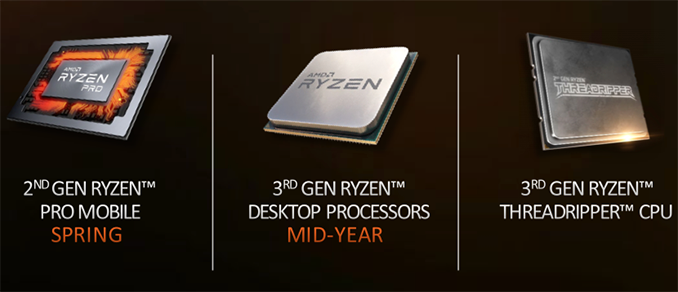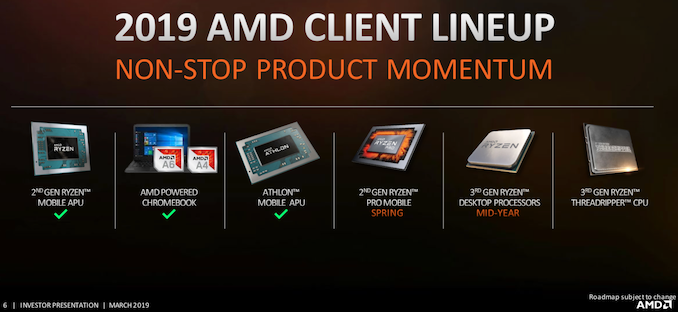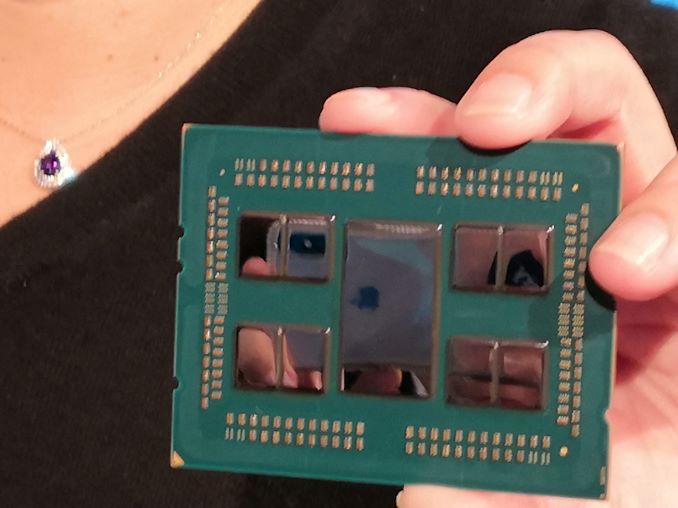AMD: 3rd Gen Ryzen Threadripper in 2019
by Anton Shilov on March 6, 2019 12:20 PM EST- Posted in
- CPUs
- AMD
- APUs
- Ryzen
- ThreadRipper
- Rome
- Ryzen 3rd Gen
- Matisse

In a new presentation for investors AMD announced a more precise launch plan for its client APUs and CPUs for desktop, mobile, and server computers. The company is preparing to update its whole lineup of products for different types of client and server machines later this year.
As it turns out, AMD intends to release its 2nd Generation Ryzen Pro mobile products for notebooks this spring. AMD also plans to introduce its 3rd Generation Ryzen processors sometimes in the middle of the year. A bit later on the company is set to launch its 3rd Generation Ryzen Threadripper CPUs for extreme desktops and workstations. AMD’s codenamed Rome processors for servers are also due in 2019, but the manufacturer does not elaborate about their exact timing.
AMD’s 2nd Gen Ryzen Pro 3000-series quad-core processors are based on the Zen+ microarchitecture and are made using GlobalFoundries’ 12LP process technology, just like their non-Pro counterparts. The latter are set to become available in the near future, so we are going to learn more about what to expect from these upcoming APUs shortly.
AMD’s 3rd Gen Ryzen processors for desktops rely on the brand-new design code-named Matisse. Matisse features two dies: a chiplet die containing eight cores based on the Zen 2 microarchitecture, and built using TSMC’s 7N manufacturing process; and an I/O die featuring PCIe 4.0 lanes, and built using GlobalFoundries’ 14LPP fabrication technology.
AMD’s 2nd Gen EPYC (codenamed Rome) and 3rd Gen Ryzen Threadripper processors have a lot in common. EPYC will have eight 7nm Zen 2-based chiplets to provide up to 64 cores and an IO die. We expect the 3rd Gen Ryzen Threadripper to be built on the same platform, but we don't expect to see parity on power/core/frequency based on how the first generation Threadripper only offered half the cores of the 1st Gen EPYC. We would be pleasantly surprised if there was core configuration parity!
This is a breaking news. We are adding more details as we learn them.
Related Reading:
- AMD Previews EPYC ‘Rome’ Processor: Up to 64 Zen 2 Cores
- AMD Ryzen 3rd Gen 'Matisse' Coming Mid 2019: Eight Core Zen 2 with PCIe 4.0 on Desktop
- The AMD Keynote at CES 2019: Looking Ahead
- AMD Reveals Radeon VII: High-End 7nm Vega Video Card Arrives February 7th for $699
Source: AMD













58 Comments
View All Comments
austinsguitar - Wednesday, March 6, 2019 - link
if they do indead release 16 or 12 core ryzen 3000 for am4... hedt will look Iidiotic to buy...austinsguitar - Wednesday, March 6, 2019 - link
dumb. woopsies. English language hitting me hard right now.Marlin1975 - Wednesday, March 6, 2019 - link
Threadripper is not just about core count but also PCIe lanes and Memory bandwith/channels.8 cores have shown to be memory limited in some cases. So 12/16 would also show weakness that a threadripper system would over come.
stanleyipkiss - Wednesday, March 6, 2019 - link
Exactly. I am looking right now at an amazing price for a 1950X for a storage system/server. I will be using all PCI lanes for 8x expansion slots. Nothing comes close to the value on offer with TR4.R0H1T - Wednesday, March 6, 2019 - link
That argument is harder to make given Ryzen 3 will also have PCIe 4.0 & probably up to 16 cores. Now unless someone needs/wants tonnes of PCIe lanes, the move to TR3 would be less rewarding. Of course the extra cores, quad channel memory & obviously workstation/server usage are the major selling points which'd still work in TR's favor.baka_toroi - Wednesday, March 6, 2019 - link
Do you have a source about Ryzen 3 having 16 cores or is it your own prediction?R0H1T - Wednesday, March 6, 2019 - link
>baka_toroiI said "up to" 16 cores & that's probably the worst kept secret ever. Do you have anything to add, other than that?
Flunk - Wednesday, March 6, 2019 - link
Which is why you'd want more memory channels on your database server. Desktop loads? Not going to matter.0ldman79 - Thursday, March 7, 2019 - link
A lot of the memory issues with Threadripper have been settled.Depending on the app even a quad core has been memory limited in the past.
There will certainly come a point where mainstream needs more memory bandwidth but currently I think we're still limited by processing power in most situations. Most, not all.
Santoval - Saturday, March 9, 2019 - link
No, the Von Neumann bottleneck is still the most serious hurdle to increased computer performance. CPUs (and to a lesser extent GPUs) are *much* faster than the main system memory they are paired with, which is why caches have been employed to alleviate the bottleneck and the size of caches keeps increasing. CPUs wait (and have waited for quite a long time) for main memory, not the other way around. CPUs are faster than main memory, faster than L3 cache, faster than L2 and even L1 cache, and are roughly as fast as the tiny memory they have in their registers (let's call that L0 cache).